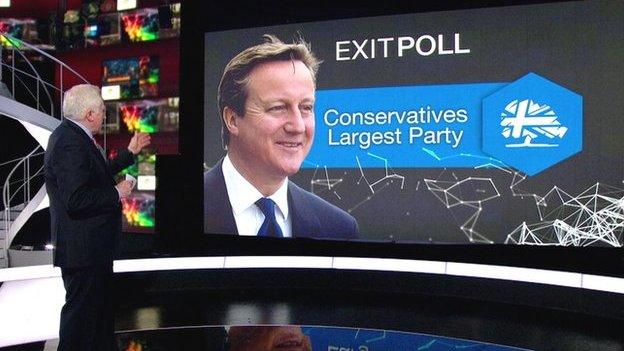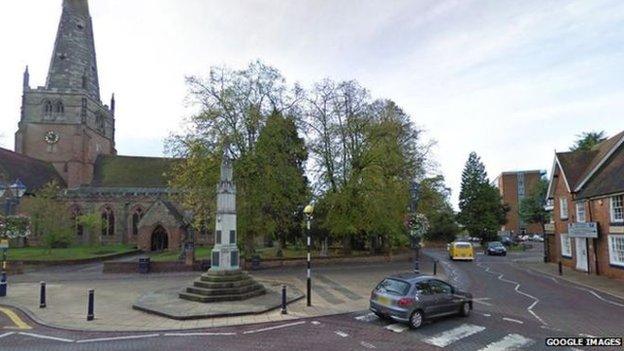Why Nuneaton was the Basildon of 2015
- Published
- comments

Conservative Marcus Jones increased his Nuneaton majority by nearly 3,000 and said voters in the Warwickshire town had 'spoken for Britain'
"Wow!"
Of all the countless syllables uttered during the political career of the one-time council leader and newly appointed Local Government Minister Marcus Jones, this will probably go down as the one that will always stand out.
Nuneaton, a former mining town sitting on the outskirts of the West Midlands commuter belt, where Warwickshire meets Leicestershire, had just delivered one of our most eagerly awaited election results.
From the moment that BBC exit poll had electrified the close of polls debates, all eyes were on the early declaring Conservative marginals - would they prove or disprove the number-crunchers' startling predictions?
I was presenting from the count in Bedworth Civic Hall as the tension mounted. I told David Dimbleby that there was great nervousness in both the Conservative and Labour camps - as well there might be.

The moment the exit poll was published on the BBC on 7 May
The 2,000 majority Mr Jones was defending meant Labour needed a swing of just 2.3% to capture it.
This made it the perfect test of whether or not Ed Miliband was on course to be the largest party. Or whether the Conservatives could even have an outright majority of their own.
By doubling his majority, Marcus Jones confirmed the Tories were on course for an unexpected win, leaving his exclamation mark in history.
It was, said Emily Maitlis, the "Basildon moment", recalling that key result in 1992 which helped put John Major back into Downing Street with a modest working majority in the teeth of poll ratings which had consistently pointed the other way.

The Nuneaton result was the 'Basildon moment' of the 2015 General Election - Basildon was a key result in 1992, re-electing John Major's Conservative government
So why were the opinion polls so wide of the mark again this time?
I have talked in previous posts about the dangers of reading across from the national headline poll ratings to individual constituencies.
With many more parties in contention than ever before, each seat had its own distinct set of interactions, making it more or less a law unto itself.
In the final stages of the campaign in our 25 or so key marginals we began to see a clear polarisation. The Conservatives were strengthening in their seats and Labour, in theirs.
In UKIP's top Midlands target seat of Dudley North, Labour's Ian Austin increased his majority too.
This was the pattern repeated time and again, with only Telford swinging from Labour to Conservative, by a majority of just 700.
This polarisation squeezed the Liberal Democrats out altogether in a region where they had only 3 seats out of 63 to start with. The former MP for Solihull Lorely Burt, and her counterpart in Cheltenham, Martin Horwood, were high-profile casualties of the determined, targeted attack by their former coalition partners.

Solihull went from Lib Dem to Conservative, with many party bigwigs making the trip along the motorway to campaign in the town
Labour captured Birmingham Yardley from the Liberal Democrat John Hemming, so for all the sound and fury of the campaign, the Conservatives had net gains of just two seats and Labour, one.
UKIP's third place in Dudley North confirmed what Nigel Farage had told me during a campaign visit: they had indeed "fallen back lately".
This again was one of the key factors in that multi-party environment in individual seats which I mentioned earlier, reinforcing his claim that the most recent 'switchers' to UKIP were predominantly ex-Labour voters.
It is now clear that significant numbers of UKIP's first wave of former Conservative supporters eventually reverted to type. Whereas 'red UKIP' held steady, posing a significant challenge to Labour as it rebuilds after a second successive heavy election defeat.
The biggest irony in all this is that 'multi-party politics' has undoubtedly played a very significant part in all this. But the political map of our part of the country is now entirely blue and red.